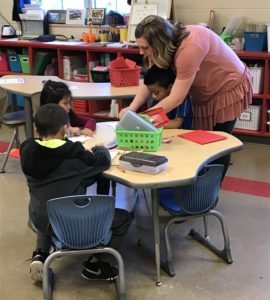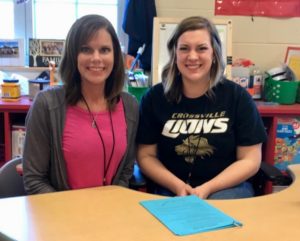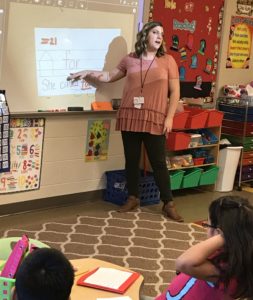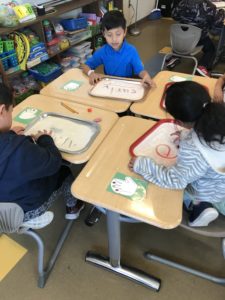
Lindsey Barrell teaches kindergarten at Crossville Elementary School.
Her kindergarten class is 100 percent Hispanic, and most students speak only Spanish at home. As a result, Barrell said, it’s been difficult for kids to retain the English they learn each day.
But since implementing Orton-Gillingham teaching strategies at the beginning of the year, Barrel said she’s seen her students’ abilities — and confidence — soar.
“My kids picked right up on it. They were able to tell me the words they learned the next day. … They know what the red words are. They know how to spell them. When I tell them a sound, they know what letter says that. They’re just not frustrated anymore because they’re getting it.”
Barrell completed Orton-Gillingham training with the Institute for Multi-Sensory Education in December.
The teaching strategy is a structured approach that breaks down reading and spelling into smaller skills involving letters and sounds, and then builds on those skills over time. Educators use sight, hearing, touch and movement to help students connect with concepts.
Regina Jones, a 29-year teaching veteran and reading specialist at Crossville Elementary School, joined Barrell.
“OG has just reignited me,” Jones said. “I was intrigued by it when I heard about it because you’re always looking for that missing piece. What is it that we’re missing? We’re working so hard, but we have too many kids that are performing below grade level.”
Jones was a classroom teacher for 25 years before transitioning four years ago to her current role as reading specialist. She taught everything from Head Start to 6th grade.

Left to right: Reading specialist Regina Jones, kindergarten teacher Lindsey Barrell
Jones said she learned the whole language approach to literacy instruction in college — and realized it didn’t work the second she began teaching. Jones has spent nearly three decades researching best practices, and said multi-sensory techniques make all the difference.
“It just makes so much sense, my goodness,” Jones said. “Why didn’t I think of this until now? The more senses you employ, the greater the retention. … This has excited me like I have not been excited in a long time.”
Crossville Elementary School in northeastern Alabama is home to roughly 630 students. Seventy-seven percent of the K-3 school is Hispanic. Of those, more than half are English language learners.
That poses unique challenges, according to Jones and Barrell.

Lindsey Barrell teaches kindergarten at Crossville Elementary School in rural Alabama.
“We’ve just seen an explosion of the ELL population,” Jones said. “It’s so hard for them to retain what they’re taught because when they leave us, they go back home and get everything in Spanish. It’s not that these kids are not intelligent — they are above intelligent.”
Jones said implementing multi-sensory techniques like vowel tents, sand trays and three-part drills is creating not only academic success but also happier students.
Kids feel empowered when they master concepts and ace tests.
So far, one teacher from each grade level K-2 has been trained in IMSE’s OG. Additional teachers will receive training in May and next school year. Jones often models lessons and fills in for teachers so they can observe their peers with ample time to take notes and ask questions.
“A lot of teachers might think: This is something else that we have to do,” Jones said. “I keep telling them: This is not a program in itself. You just incorporate it into what you’re already doing. … You don’t have to just scratch what you’ve been doing. You just have to incorporate these multi-sensory strategies.”
In early elementary school classes, that’s especially important.
“Research says that by the end of third grade, approximately 75 percent of struggling readers won’t ever catch up,” said Brooke Curlee, a regional reading specialist with the Alabama Reading Initiative (ARI), a statewide effort aimed at improving literacy rates in public schools. “It’s more difficult to fix the reading interferences after the end of third grade.”
“It wasn’t just dyslexic students who would benefit. These strategies work with all students.”
It was Curlee who introduced Barrell to Orton-Gillingham. Curlee is an 18-year teaching veteran who has worked as a school reading specialist, curriculum specialist, transformation specialist and fourth-grade teacher.
She works with eight school systems to coach teachers, help with data analysis, model lessons and more. In her current role as an ARI regional reading specialist, she works with eight school systems to support ARI-funded, school-based reading specialists in their data analysis, coaching of teachers and professional learning.

Barrell said she knew she wanted to be trained after watching Curlee teach a red word lesson.
“She worked with my class for 30 minutes, and they picked up on it so fast. It didn’t take long at all,” Barrell said. “Red words are hard for our kids. They’re hard for all kids, but especially for [English language learners]. … My kids were able to tell me the words they learned the next day. They just knew it.”
In December, Barrell’s students tackled one red word per week. Now, after three months of Orton-Gillingham instruction, they’re up to four.
“I can see the growth tremendously,” Barrell said. “They love the sand and the three-part drills. They get excited about it all.”
IMSE believes that all children should be able to read. To achieve this end, IMSE wants to bring Orton-Gillingham to all educators to give children the best literacy instruction possible.
Learn more about what you can do to improve literacy for all using the Institute for Multi-Sensory Education’s Orton-Gillingham training.
Please connect with us on Facebook, Twitter, and Pinterest to get tips and tricks from your peers and us. Read the IMSE Journal to hear success stories from other schools and districts, and be sure to read the OG Weekly email series for refreshers and tips.
